How to create a Windows 10 installation disk
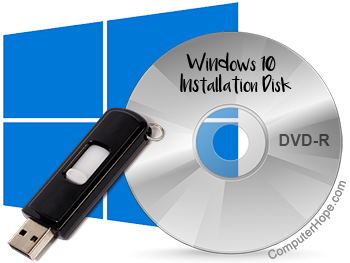
If your computer runs Windows 10, it's a good idea to have a bootable Windows installation disk, in case you ever want to reinstall Windows on your computer.
If you don't have a Windows 10 disk, create one using the methods described below.
Requirements
Before you create a bootable Windows 10 disk, make sure you have the following:
- A computer connected to the Internet, with a USB (universal serial bus) port or DVD burner.
- A USB flash drive with a capacity of at least 8 GB, which is either empty or ready to be completely erased; or a blank DVD-R (Digital Versatile Disc Recordable) disk.
- A valid Windows 10 license; either a numeric license key or a Microsoft account with a Windows 10 license that is associated with your computer.
Method 1: Use the Media Creation Tool
The Media Creation Tool is a program provided by Microsoft that downloads all required files, and write them to your DVD (Digital Versatile Disc) or USB flash drive. Follow these instructions to download and use the Media Creation Tool.
The following steps will completely overwrite the data on your USB flash drive. All existing data on the disk will be destroyed.
- Open a web browser and go to Microsoft's Windows 10 download page. Under Create Windows 10 installation media, click Download tool now.
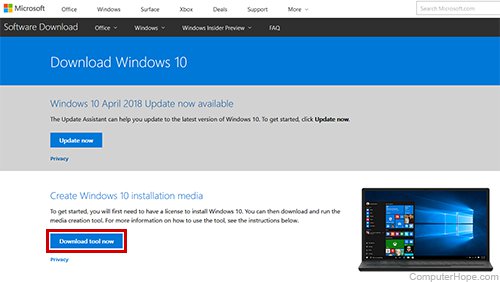
- Run the installer. At the UAC (User Account Control) prompt, click Yes. The installer gets things ready, then displays Notices and License terms. Read the terms and click Accept to proceed.
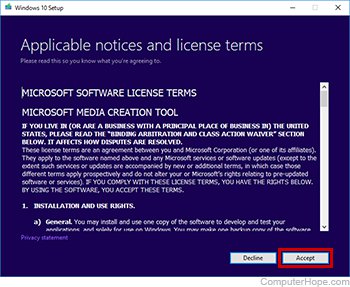
- At the screen What do you want to do?, select Create installation media for another PC, and click Next.
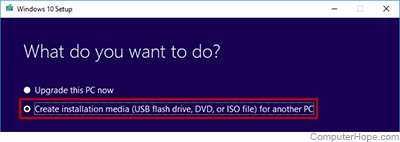
- At Select language, architecture, and edition, don't change anything if you're creating the installer for this computer. Make sure Use the recommended settings for this PC remains checked. (If you're creating a disk for another computer, uncheck this box and make changes now.) To continue, click Next.
- At the Choose which media to use screen, choose USB or DVD as the destination. In this example, we create a USB flash drive. Select USB flash drive, and click Next.
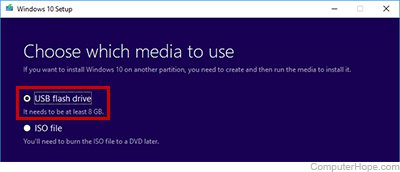
- You are asked to Select a USB flash drive. If your USB flash drive is not inserted, insert it now, wait a few moments, and click Refresh drive list. Then, select your USB flash drive and click Next.

- Windows 10 downloads the installer and writes it to your USB flash drive. Your PC can be used for other activities while it runs in the background.
- When it's finished, a Your USB flash drive is ready message is displayed. Click Finish. Temporary files are cleaned up and the program exits automatically.

Eject and remove your USB flash drive from the computer. For information about how to use it, see how to boot with your installation disk, below.
Method 2: Download ISO and create bootable USB
Download the Windows 10 ISO image file to your computer and create your bootable disk manually with another program.
If you're using Windows, you must use the Media Creation Tool to download the ISO. If you're using another operating system, such as macOS or Linux, Microsoft offers a direct download.
Windows: Download ISO with Media Creation Tool
If you're using Windows, follow these steps to download the Windows 10 ISO with the Media Creation Tool. (Steps 1–4 are the same as in method 1.)
- Open a web browser and go to Microsoft's Windows 10 download page. Click Download tool now.
- Run the installer. At the UAC prompt, click Yes. Read the license terms and click Accept.
- Select Create installation media for another PC, and click Next.
- At Select language, architecture, and edition, don't change anything if you're creating the installer for this computer. Click Next.
- At Choose which media to use, select ISO file, and click Next.
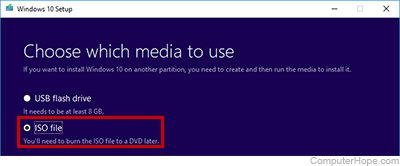
- Choose a location on your computer to download the ISO file, such as your Downloads folder. Make sure you have enough space to download the file (it's big - between 3 and 5 gigabytes, depending on the version).
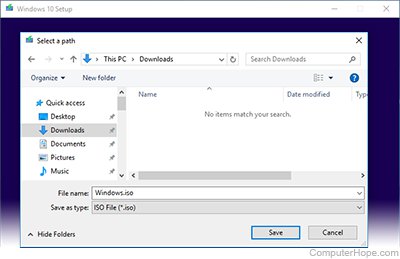
- When the download is complete, Media Creation Tool offers to Burn the ISO to a DVD. It also displays the full path and file name of the ISO file on your computer.
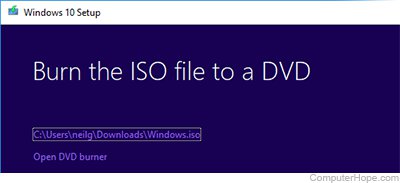
Optional: To verify the location of the file, click the file name to open the folder where it was downloaded.
Optional: To burn a DVD of the ISO now, click Open DVD Burner to open the Windows Disk Image Burner. Insert a blank DVD-R disk in your DVD drive and follow the instructions.
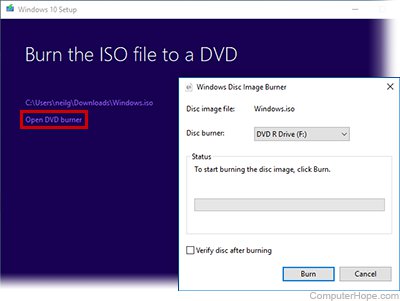
- Click Finish to close the Media Creation Tool.
Now, skip to the step create bootable USB with Rufus.
macOS X, Linux: Download ISO directly
If you're using a non-Windows operating system, follow these instructions to download the Windows 10 ISO.
- Open a web browser and go to the Windows 10 ISO download site. Microsoft detects your operating system and reroutes you to the direct download page.
- Under Select edition, select Windows 10 and click Confirm.
- Under Select the product language, select your language (English, for example), and click Confirm.
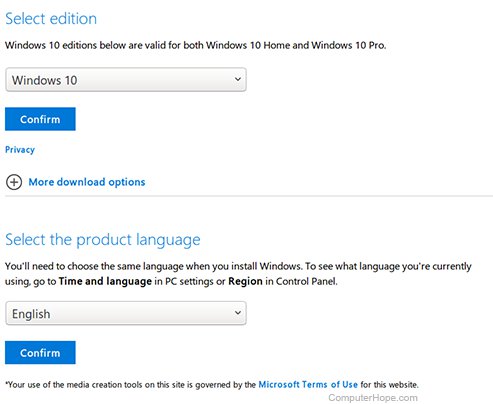
- Under Downloads, you'll download the 32-bit or 64-bit version of Windows. If your computer has a 64-bit CPU (Central Processing Unit), choose the 64-bit Download. If you're unsure, see: How to determine if you have a 32-bit or 64-bit CPU.
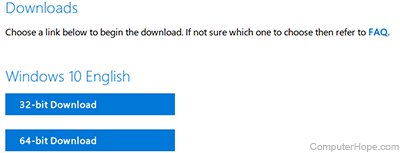
- The download begins in your browser. Make sure you have enough disk space to download the file (it's big - between 3 and 5 gigabytes, depending on the version).
Create bootable USB with Rufus
Now that you've downloaded the ISO file, you need special software to create a bootable USB flash drive with it. Only copying the file to the USB does not work.
There are various programs used to create a bootable USB flash drive in Windows, such as UNetbootin. In these instructions, we use a free Windows program called Rufus.
The following steps completely overwrite the data on your USB flash drive. All existing data the USB flash drive is destroyed.
- Open a web browser and go to the Rufus website. Scroll down to Download, and choose either Rufus or Rufus portable (either one works).
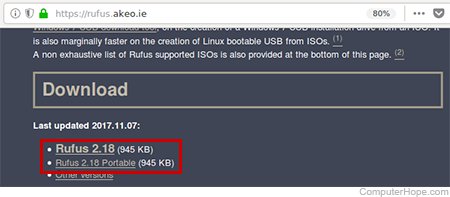
- When the download is complete, run the Rufus executable. You don't need to install it because the program runs without being installed.
- If your USB flash drive is not inserted, insert it now to be recognized by Rufus.
- Click the disk icon. It looks like an optical drive and disk. Navigate to the Windows ISO you downloaded, select the ISO file, and click Open.
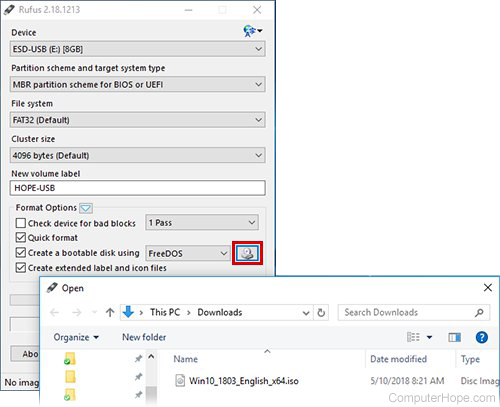
- The Rufus status line shows "READY." To write the ISO to your USB flash drive, click Start.
- Rufus warns you that all data on the USB will be destroyed. If you have any important files on the USB flash drive, this is your last chance to cancel and back up your files. To proceed, click OK.
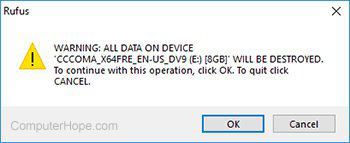
- The ISO is written to the USB flash drive. It should only take a few minutes.
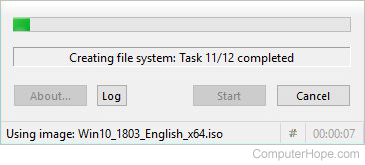
The process is complete when the progress bar is fully green and the status line says "READY" again.
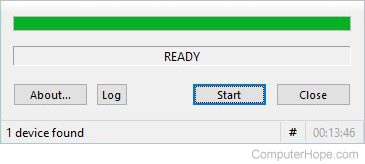
- Click Close to exit Rufus.
How to boot with your installation disk
To use your Windows 10 installation disk, follow these steps.
- Verify the computer's BIOS (Basic Input/Output System) is configured to boot from a removable disk. To access your BIOS, reboot the computer and press a specific key before boot sequence begins. For detailed instructions, see: How to enter and exit the BIOS or CMOS setup.
- If necessary, change your boot sequence so the DVD/USB drive is listed before your HDD (Hard Disk Drive) or SSD (Solid-State Drive) in your boot order. (If you don't see your USB drive in the list, insert your installation USB flash drive before powering on the computer and try again.)
- If your BIOS is properly configured, power down the computer.
- Insert your installation disk.
- Power on the computer.
Instead of loading the operating system from your HDD/SSD, your computer boots from your removable disk, and the Windows installation begins.
